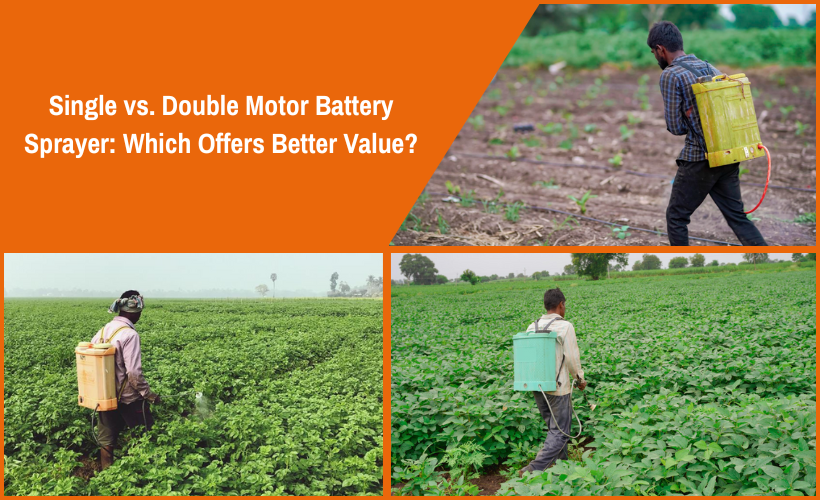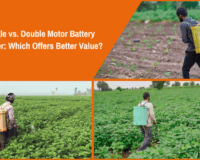Modern farming is all about efficiency, precision, and comfort and that’s exactly what the battery sprayer delivers. Whether you’re managing a large farm or maintaining a small garden, this modern tool has made applying pesticides, fertilizers, and herbicides far easier than traditional manual pumps.
But when it’s time to upgrade your sprayer, one common question arises: should you choose a single motor or a double motor model?
This guide will help you decide which option offers the best value, explain the powerful Double Power model, and show you how to fix common sprayer issues so your machine performs perfectly all year long.
Full information about Double Power Battery Spray Pump
The right choice depends on your workload and spraying needs. Both are portable and electrically powered, but they differ in performance.
| Feature | Single Motor Sprayer | Double Motor Sprayer |
| Pressure & Flow Rate | Lower (around 3–5 LPM) | Higher (around 8–10+ LPM) |
| Spray Range | Shorter – ideal for gardens or low crops | Longer – up to 20+ feet vertically |
| Battery Life | Longer (uses less power) | Shorter (uses more power) |
| Price | More affordable | Higher cost |
| Best For | Home gardens, small farms | Large fields, orchards, tall trees |
The Value Verdict
✅ For small-scale farmers or gardeners:
A single motor sprayer is more cost-effective and runs longer on one charge — ideal for day-to-day use.
✅ For large-scale or commercial farms:
A double motor sprayer is worth the higher price. Its stronger pressure and longer spray range allow faster, more efficient coverage of big areas.
Inside the Double Power Battery Spray Pump
The Double Power or Dual Motor model is built for high performance and long-range spraying. It’s perfect when you need to cover large fields or tall crops quickly.
Key Features:
- Dual Motor System: Produces up to 150–160 PSI pressure and 8–10 LPM flow rate. Some models let you switch between single and dual motor modes to save power.
- High-Capacity Battery: Usually comes with a 12V 12Ah or 14Ah battery for longer operation.
- Backup: Can spray 15–20 tanks (20L each) on one charge, offering 5–7 hours of use.
- High Spray Range: Reaches up to 20 feet vertically and 30 feet horizontally — great for orchards and plantations.
- Tank Design: Strong 20L HDPE tank with comfortable shoulder straps and back padding.
- Accessories: Includes various nozzles, a telescopic lance, charger, and battery status meter.
Price Range
A good Double Power model costs between ₹3,500 and ₹5,500, depending on the battery type and motor quality.
Troubleshooting a battery sprayer: 7 common issues and easy fixes.
Even reliable machines can face small issues. Here are some quick fixes:
- Sprayer Not Turning On – Check the battery charge and tighten wire connections.
- Low Pressure – Clean clogged filters or nozzles.
- Pump Not Spraying – Remove airlocks and ensure all fittings are tight.
- Leakage – Replace worn gaskets or O-rings.
- Uneven Spray – Clean or replace the nozzle tip.
- Battery Not Charging – Check charger connections and clean battery terminals.
- Unusual Noise – Clear debris from the pump head or contact a technician if needed.
Tip: Always flush your agriculture spray machine with battery after every use. Clean water prevents clogging and extends the life of your battery sprayer for agriculture.
Final Thoughts
Whether you’re a home gardener or a professional farmer, investing in a high-quality battery sprayer can greatly improve your productivity and comfort.
Choose a single motor model for light-duty spraying or a double motor version for powerful, long-range applications. With proper care, your battery sprayer pump will deliver reliable performance season after season helping you maximize your harvest with ease.
FAQ
Q1. What is a battery sprayer and how does it work?
A battery sprayer is a portable spraying device powered by a rechargeable battery instead of manual hand-pumping. It uses an electric motor and pump to build up pressure and spray liquid chemicals (pesticides, herbicides, fertilizers) evenly across crops or plants — removing the need for constant manual pumping.
2. What are the advantages of a battery sprayer for agriculture over a traditional manual sprayer?
The key advantages include:
- More consistent pressure and spray pattern, leading to better coverage and fewer missed spots.
- Reduced labor and fatigue — no constant pumping means less physical strain.
- Time efficiency and potentially lower chemical wastage thanks to uniform application.
3. How should you maintain your agriculture spray machine with battery to ensure long life and reliable performance?
Key maintenance steps:
- After each use, flush the tank and spray system with clean water to prevent clogging and chemical buildup.
- Use the correct charger, avoid over-discharging or overcharging the battery, and store it in a dry, moderate environment.
- Regularly inspect nozzles, filters, hoses, seals, and check for signs of wear or leaks — replace parts as needed.




